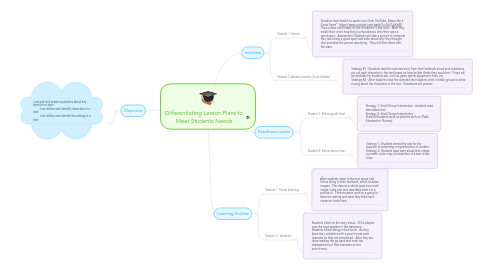
1. Objective
1.1. I can ask and answer questions about key details in a text: I can define and identify characters in a text. I can define and identify the setting in a text
2. Interests
2.1. Student 1: Sports
2.1.1. Students listen/watch to sports story from YouTube, Always Be a Good Sport". https://www.youtube.com/watch?v=0JvTJchlk48 Then create circle maps on the characters in the story. After they create their circle map they journal about a time they were a good sport. Assessment: Students will take a picture of someone they see being a good sport and write about why they thought that and what the person was doing. They will then share with the class.
2.2. Student 2: Artistic/creative (loves theater)
2.2.1. Strategy #1 - Students read the selected story from their textbook aloud and volunteers act out each character in the text based on how he/she thinks they would act. Props will be available for students use, such as glass, sports equipment, hats, etc. Strategy #2 - After students read the selected text students work in table groups to write a song about the characters in the text. Volunteers will present.
3. Readiness Levels
3.1. Student 1: Below grade level
3.1.1. Strategy 1: Small Group Intervention - students read decodable text. Strategy 2: Small Group Intervention - Teacher/Students work on phonics skills on iPads (Hooked on Phonics).
3.2. Student 2: Below above level
3.2.1. Strategy 1: Students reread the text for the purpose of extending comprehension of content. Strategy 2: Students read story aloud then create a present circle map of characters of a text to the class.
4. Learning Profiles
4.1. Student 1: Visual Learning
4.1.1. After students listen to the text aloud and follow along in their textbook, which includes images. The class as a whole goes over each image in the text and describes what it is a picture of. Then students work as a group to draw the setting and what they think each character looks likes.
4.2. Student 2: Auditory
4.2.1. Students Listen to the story aloud. CD is played over the loud speaker in the classroom. Students follow along in their book. As they listen they underline with a post-it-note each character as they are introduced. After they are done reading the go back and write the characteristics of that character on the post-it-note.
